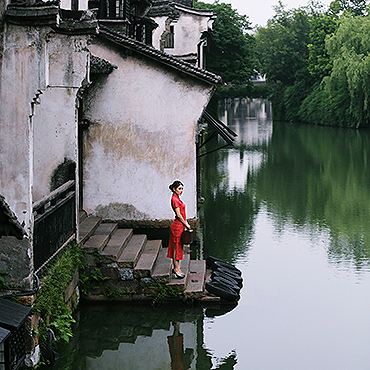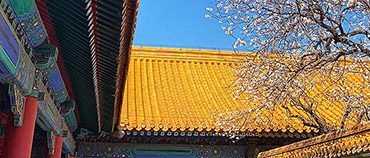
We’ve blogged before about how traditional Chinese architecture can be a little overwhelming and confusing, especially if you’re trying to decipher its meaning on your first China tour.
Like many aspects of local culture, traditional Chinese architecture styles have endured. Surviving millennia, the various distinct styles are usually the hallmark of a particular period in Chinese history.
To the untrained eye, the various architectural features, such as the bilateral symmetry, open compounds within buildings, and the deep cosmological and mythological symbolism inherent in design and structure, can make it difficult for a novice to really understand the significance of a building. In fact, when you’re traveling on a busy China tour, all the culture, buildings and stories behind them can become a blur.
So with that in mind, let’s simplify the complexity around traditional Chinese architecture so you can make the most of every minute on tour – and maybe even share a few fun facts with family and friends when you arrive home.
Different styles, different places
A good rule of thumb that applies to the styles of traditional Chinese architecture is remembering that each distinct style is associated with a particular region in the country.
Now you may not remember which style originates in each region, or even where each region is, however, at least you’ll be aware that not all styles are found everywhere in China.
In the table below, we’ve summarized these styles of architecture and the regions they’re found in, as well as the typical features associated with each one.
| Architecture style | Region | Features |
| Wan (皖派) | Anhui | Grey blue tiles, white walls, and carved bricks |
| Su (苏派) | Jiangsu and Zhejiang | Hills, water, and winding paths |
| Min (闵派) | Fujian | Earth building defense function |
| Jing (京派) | Beijing | Symmetrical courtyard layout, Chinese cultural symbol |
| Jin (晋派) | Shanxi, Shaanxi, Ningxia and Gansu | Cave houses, historical culture of the Shanxi merchants |
| Chuan (川派) | Sichuan, Yunnan and Guizhou | Stilt houses, colorful ethnic minority features |
As with much of Chinese culture, the distinctive style specific to each region tells a unique story in this first of a two-part series, you can discover the basics and come to appreciate the significance of each on your journey through China.
Wan (Hui) style architecture

Wan – or Hui – style architecture is perhaps the most well-known and easily recognizable styles among the six.
How will you know it? Well, if you’ve ever seen the traditional white folk houses with grey tiled roofs that are prominent in marketing for China tours, that’s Hui-style architecture.
Found in southern China, these traditional buildings are now World Heritage listed. They are recognizable as folk houses, ancestral temples and archways, which are all considered to be the ‘masterpieces’ of Hui style.
Carvings are also synonymous with Hui style architecture, with wood, stone and brick all used for decorative effect. The incredible skill applied by the traditional craftsman is only to be admired, and while the often ornate and intricate details have withstood the test of time, it is hard to find a modern equivalent that even comes close to the same level of work.


Typical Hui-style folk houses are surrounded by high courtyard walls. The ingenious design saw rainwater from roofs flow into courtyards, symbolic of the philosophy maintained by the ancient Anhui merchants who believed that ‘fertile water does not flow into the fields of other people’.


Another distinctive feature of Hui-style buildings is the patchwork of horse-head walls. Not only does this create a beautiful profile for these buildings, but it also integrates the wisdom of the Anhui people. The cleverness of this design is found in its ability to slow and even prevent a fire from spreading through a building, making it safe, reliable, and ingenious.
Su style architecture

There’s every chance you’ll recognize Su style architecture too. Think beautiful Chinese gardens, tranquil water, weeping willows – it’s the kind of quintessential scene from a Chinese silk painting you’d expect to find on your travels.
Su style architecture has existed in Jiangsu and Zhejiang gardens for thousands of years. Thoughtful garden layout encompassing different plants and structures is one of its salient features. Su style architecture is also associated with high warped ridge angle roofs, decorative gates, arcades, and windows. Along with gardens characterized by winding paths, murmuring streams, rockeries, birds, and fish, Su style brings a sensibility and artistic charm to traditional Chinese architectural design.

Fine examples of Su style architecture can be found in some of the best Jiangnan water towns , located south of the Yangtze River. Here days can be spent wandering through the picturesque and pretty streets and canals that are a stark contrast to the big city bustle found elsewhere in China.
Min style architecture

Min style architecture can only mean one thing: Fujian Province. Popular in the southern region of the province, the distinctive tulou enjoys a history that spans hundreds of years, with historians believing they were built as far back as the 12th century.
Tulou are appreciated for their superb engineering, which uses a design that relies on heavily-packed earth walls that are nearly two metres thick. They are usually round or square in shape, with well-known examples found in Yongding and Nanjing. Up to five storeys high and the capacity to accommodate several hundred people, tulous were always intended to be highly functional, keeping enemies out and residents safe.

Now a source of interest to local and international historians, anthropologists, and of course, those taking a China tour, seeing these unique buildings is certainly the stuff of beautiful travel memories.
Interested and want to know more?
Why not join us on one of our thoughtfully curated China culture tours where you can experience the very best in traditional Chinese architecture?
Explore with us and we’ll help bring your travel dreams to life.
** Information for this article was sourced from Wikipedia and WeChat Public Account ID: www1shoucangcom
ChinaTours.com is dedicated to helping western travelers from the United States, United Kingdom, Australia, Canada, and elsewhere enjoy an authentic experience of China, including those keen to learn and appreciate more of China’s traditional Chinese architecture styles. Many of our tours are culture-focused, offering the chance to dive deep into your exploration and learning. We can also tailor a tour that covers an area or region that is of particular interest to you. Want to know more? Just ask us! We’re here to share your passion for learning and all things culture-related. Enquire via our contact form and we’ll respond within 24 hours.




 Beautiful China!
Beautiful China!







